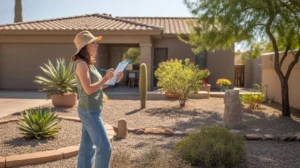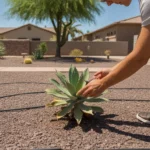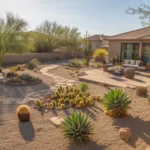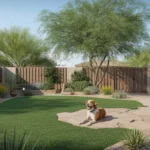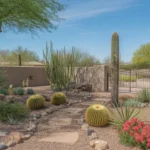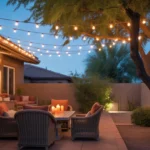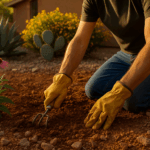As the scorching Arizona summer reaches its peak, it’s the perfect time to take a critical look at your Mesa yard and evaluate how it’s holding up. By mid-summer, you’ll have a clear picture of which plants, design elements, and maintenance strategies are working well—and which ones might need some fine-tuning. Let’s dive into some key areas to assess during your mid-summer yard evaluation.
Assess Your Plant Health and Hydration
Start by closely inspecting your plants, paying attention to signs of stress, disease, or pest damage. Look for yellowing or wilting leaves, stunted growth, or unusual spots or markings. Keep in mind that even desert-adapted plants can struggle in the intense heat if they’re not properly established or if your irrigation is off.
Next, evaluate your soil moisture levels. Dig down a few inches in several spots to see if the soil is dry, soggy, or just right. Adjust your irrigation schedule as needed to ensure your plants are getting the right amount of water for the conditions. Remember, overwatering can be just as damaging as underwatering, especially in Mesa’s clay-heavy soils.
If you’re noticing persistent issues with certain plants despite proper care, consider replacing them with more resilient, desert-adapted varieties. Consult with a local nursery or landscape professional for recommendations that will thrive in your specific micro-climate.
Evaluate Your Hardscaping and Outdoor Living Spaces
Your mid-summer evaluation is also a great time to assess the condition of your hardscaping elements, like patios, paths, and retaining walls. Check for cracks, shifting, or drainage issues that may have emerged over the hot months. Address any problems promptly to prevent further damage.
Consider how well your outdoor living spaces are functioning in the heat. Are your shade structures providing adequate relief? Is your outdoor furniture holding up to the intense UV rays? Make note of any areas that could benefit from additional shade, heat-resistant materials, or cooling features like misters or fans.
If you’re planning any new hardscaping projects, like the outdoor lighting ideas discussed in our article on Planning Ahead for Outdoor Lighting Ideas, summer is a great time to start sketching out your plans. You can assess how the sun and shade hit your yard at different times of day to optimize your layout.
Reassess Your Soil Health and Amendments
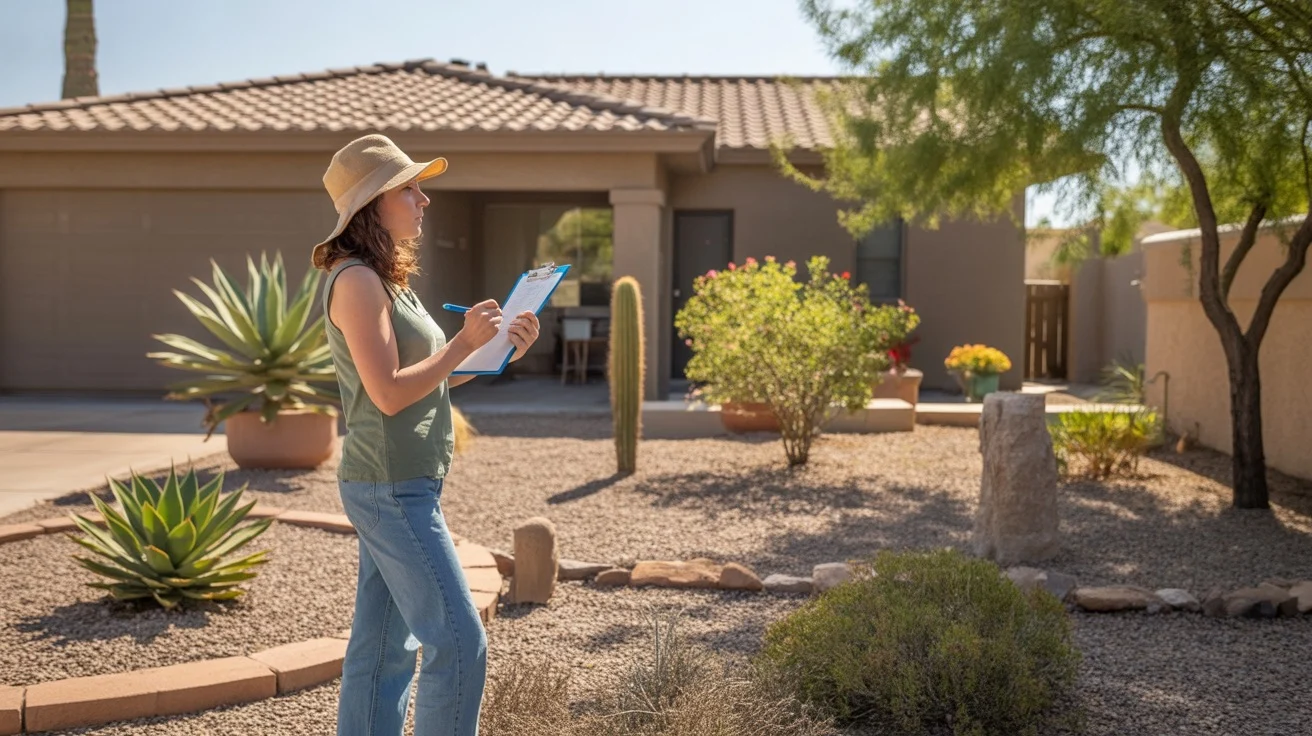
Mid-summer is a good checkpoint to evaluate your soil’s health and structure. Mesa’s native soil tends to be heavy in clay, which can compact and harden in the heat, impeding drainage and root development. Refer back to our tips in Why Clay Soil Needs Extra Love in May to see if you’re due for additional amending.
Consider having your soil tested to check nutrient levels and pH. Many local extension offices offer affordable soil testing services. Based on the results, you can tailor your fertilization and amendment strategy heading into fall.
If you’ve been consistently working compost, mulch, and organic matter into your soil over the past few seasons, you should start seeing improvements in soil structure and plant health. Keep up the good work! Improving Mesa’s dense soils is an ongoing process.
Inspect Your Irrigation System
Your mid-summer evaluation is the perfect opportunity to give your irrigation system a thorough checkup. Run each zone manually and look for signs of leaks, clogs, or misdirected sprinkler heads. Repair or adjust any problem areas to ensure your system is operating at peak efficiency.
Consider upgrading to smart irrigation controllers that automatically adjust watering based on local weather conditions. These systems can help you fine-tune your watering schedule to your plants’ changing needs while minimizing water waste. Many models can even be controlled from your smartphone for added convenience.
If you have areas of your yard that are chronically dry or soggy, you may need to modify your irrigation layout or swap in more efficient emitters. Drip irrigation can be a water-wise choice for delivering moisture directly to plant roots. Consult with a local irrigation specialist if you need help troubleshooting or redesigning your system.
Plan Ahead for Fall Planting and Projects
While it may seem premature to think about fall in the midst of the summer swelter, experienced Mesa gardeners know that autumn is prime planting season in the low desert. Use your mid-summer evaluation to start planning ahead for any fall planting or landscaping projects.
Assess which areas of your yard could benefit from additional trees, shrubs, or groundcovers for shade, beauty, or erosion control. Research native and desert-adapted species that will thrive in your specific conditions. By planning your plant list and layout now, you’ll be ready to hit the ground running when the cooler weather arrives.
If you have any hardscaping or outdoor living projects on your wish list, start sketching out your ideas and gathering inspiration. Consult with local professionals to get a sense of timelines and budgets so you can plan accordingly. By tackling major projects in the fall, your new features will be ready to enjoy come spring.
Celebrate Your Successes and Learn From Challenges
As you wrap up your mid-summer yard evaluation, take a moment to celebrate the areas where your landscape is thriving. Note the plants, practices, and design elements that are working well so you can build on those successes in future seasons.
For the areas that fell short of your vision, approach them as opportunities for growth and improvement. Every challenge is a chance to deepen your understanding of your unique landscape and hone your desert gardening skills. Reach out to local resources—like extension offices, nurseries, and fellow gardeners—for advice and support.
Remember, cultivating a beautiful, resilient yard is an ongoing journey, especially in a challenging climate like Mesa’s. By taking the time to critically evaluate your landscape mid-summer, you’ll be well-positioned to make strategic improvements that will help your yard thrive for seasons to come. With persistence, adaptability, and a healthy dose of desert know-how, you can create an outdoor oasis that’s the envy of the neighborhood.

